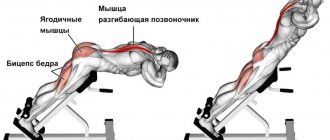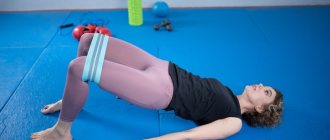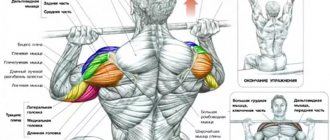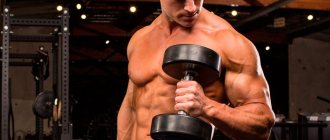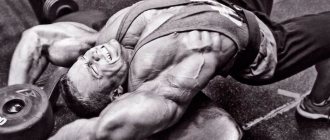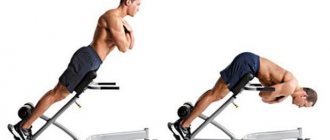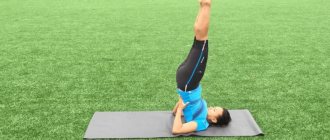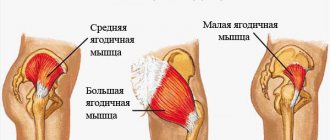Hyperextension: what is the essence of the exercise?
Hyperextension is a popular exercise performed in the gym. “In the literal sense, the term “hyperextension” means “extension,” or more precisely, “hyperextension,” so the exercise that we are used to doing in the gym, from a terminological point of view, is more correctly called “extension,” explains Yulia Malenchuk, an expert in group programs. X – Fit in Russia.
It is a mistake to think that hyperextension is “intended” to work only the back muscles. “Hyperextension is a pelvic-dominant exercise. The spinal extensors work statically, the hip extensors give dynamics to the movement,” Sergei Artyushenko, coach of the ArtFitness club, makes things clear.
However, the back muscles, buttocks, and the muscles of the back of the thighs receive part of the load here.
“The following muscle groups are involved in this movement: quadratus dorsi (extensor), biceps femoris (biceps femoris), semitendinosus femoris, semimembranosus femoris, gastrocnemius and gluteus maximus,” says Nikita Kusakin, coach of the ArtFitness club.
What types of hyperextension are there?
Unlike other exercises (such as lunges), hyperextensions do not have the same abundance of options. The main variations of the movement are either training on the floor or in a special simulator. “The most appropriate and injury-safe option is in a special simulator (the shins are fixed in supports, the front surface of the thigh lies on the platform), where we perform flexion-extension in the hip joint with a fixed lower back,” says Yulia Malenchuk. — This variation is aimed at training the extensor muscles of the hip joint: the gluteal muscles, the muscles of the back of the thigh, the adductor muscles (they work here in a dynamic mode, that is, they lengthen and relax when lowering the body and contract when lifting), as well as the extensor muscles of the vertebral column column (they work statically, maintaining a neutral position of the lower back, that is, their direct function is trained, which these muscles must perform in life).
It is also permissible to replace this exercise with an alternative one. “The movement closest to this one in terms of biomechanics is the Romanian deadlift or straight-legged deadlift,” says Yulia Malenchuk. — Essentially, the same movement is performed (flexion-extension of the hip joint) and the same muscles are trained. However, this movement will be technically more complex, since the body is not fixed in the simulator, and it is necessary to control its work in space.”
Content
https://youtube.com/watch?v=2MKRkxksdQw%3F
Back muscles
are located in several layers, so they are divided into deep and superficial, which, in turn, are also located in two layers. Let's consider only those muscles that determine the relief of the back.
Trapezius muscles Edit
Trapezius muscle, m. trapezius
, a flat, broad muscle, occupies a superficial position in the back of the neck and in the upper back. The trapezius muscle has the shape of a triangle, with its base facing the spinal column and its apex facing the acromion of the scapula; The trapezius muscles of both sides together are shaped like a trapezoid. The tendon bundles of the muscle are short and only in the area of the lower cervical and upper thoracic vertebrae, reaching a great length, they form a diamond-shaped tendon area. The muscle bundles converge radially towards the scapula.
Main function:
contracting with all its bundles, the muscle brings the scapula closer to the spinal column; contracting with the upper bundles, it raises the scapula, and with the lower ones, it lowers it. When fixing the scapula, both trapezius muscles pull the head back, and with unilateral contraction the muscle tilts the head in the corresponding direction.
Latissimus dorsi Edit
Latissimus dorsi muscle, m. latissimus dorsi
, occupies the entire lower back, with its upper part coming under the lower end of the trapezius muscle. It originates from the spinous processes of the last four (and sometimes five and six) thoracic, all lumbar and sacral vertebrae, as well as from the posterior part of the iliac crest and, finally, four teeth from the four lower ribs. These teeth alternate with the posterior teeth of the external oblique muscle. From their origin, the fibers of the latissimus dorsi muscle go upward and laterally in a converging direction and are attached to the crest of the lesser tubercle of the humerus (crista tuberculi minoris humeri).
Main function:
brings the shoulder toward the body and pulls the upper limb back toward the midline, rotating it inward (pronation). When the upper limb is strengthened, it brings the torso closer to it or takes part in the displacement of the lower ribs upward during the respiratory movement, thus being an auxiliary respiratory muscle.
Rhomboid muscles Edit
Rhomboid muscle, m. rhomboideus
, lies under the trapezium, having the shape of a rhombic plate. It starts from the spinous processes of the two lower cervical and four upper thoracic vertebrae and is attached to the medial edge of the scapula.
Main function:
when contracted, the rhomboid muscle pulls the scapula toward the spine and upward. Fixes the medial edge of the scapula to the chest.
Back extensors Edit
The erector spinae muscle. The longest and most powerful muscle of the back. Located along the lumbar spine. It is divided into 3 parts: spinous, longissimus and vertebral-costal.
Main function:
with bilateral contraction, it extends the spinal column. When unilateral, it tilts in its direction. Participates in lowering the ribs and turning the head. The muscle plays an important role in maintaining correct posture and maintaining balance.
Hyperextension: basic mistakes
This exercise is often performed with errors, disrupting the biomechanics of movement. “Unfortunately, in most cases, hyperextension is performed somewhat incorrectly,” says Alexey Bolyaev, personal trainer at the Women Secrets women’s fitness studio in Tsaritsyno . “And in the way I often see it, there is more harm than good.”
We have compiled a list of the main mistakes that are made when performing hyperextension. These include:
Hyperextension of the lower back. “In this case, the vertebrae can compress the intervertebral discs, which often leads to protrusions and hernias,” adds Alexey Bolyaev.
Incorrect neck position. “Often it is also hyperextended during the exercise; normally, the neck should be simply an extension of the spine,” reminds Nikita Kusakin.
Incorrect “setting” of the simulator. “If you place the machine bench too high or too low, you will disrupt the biomechanics of the movement. Watch this,” warns Nikita Kusakin.
What you should pay attention to? “When working in the simulator, it is important to set it up correctly: the hip supports should end just below the hip joint so as not to interfere with the lowering of the body,” advises Yulia Malenchuk.
Excessive weight of burdens. It is permissible to perform hyperextension by picking up a dumbbell or a barbell disc. But you should not take equipment that is too heavy, this will disrupt the execution technique.
Knee bending. When performing exercises in the simulator, watch the position of your legs: do not bend your knees, as this will “shift” the load from the target muscles.
Execution Features
The body must be fixed motionless so that the muscles feel the load. During the bending process, a level should be formed so that the bar hangs parallel to the knees.
Experts advise using a grip slightly wider than shoulder width, which will create a wide range of motion of the bar and elbows. Try to pull your elbows as high as possible; if the bar cannot reach your waist, the effectiveness of the exercise is noticeably reduced.
You should also not round your back, as this can lead to muscle strain and soft tissue damage. The best option would be the natural bend of the spine. There is no need to pick up too heavy a weight so as not to injure the arm muscles.
To actively work the muscles of the upper back, you need to pull the barbell towards your chest, while placing your elbows to the sides. Bend your legs at the knees during the process so as not to lose your center of gravity. Following the correct technique will help achieve high-quality results and increase the effectiveness of your training.
How to perform hyperextension correctly
To avoid these mistakes, learn the correct technique for performing hyperextension.
So, fix your body position in the simulator. “You can cross your arms over your chest, or take a weight (an option for those who are prepared!). As you inhale, smoothly lower down, keeping your lower back in a neutral position, you should feel a stretch in the muscles of the back of the thigh, as you exhale, rise until the body and legs form a straight line, says Yulia Malenchuk. — When performing this exercise, it is important to monitor the parallelism of the feet (if one foot turns out more than the other, the load on the legs will be uneven), the smoothness of the movement (do not “fall down”, rise up smoothly, and not jerkily due to inertia), the work of the lower back (maintain a neutral position, no flexion-extension in the lumbar region) and range of motion (avoid hyperextension).”
Shoulder exercises
To train the front, middle and rear deltas, the following equipment is used:
Seated press. Muscles involved: anterior and middle deltoids. The simulator is effective for developing a strong and beautiful upper shoulder girdle. The seated design allows you to relieve the spine as much as possible. The handle feed lever and adjustable seat height and backrest angles make exercising on it as comfortable as possible.
Seated fly-out. Muscles involved: middle and anterior deltoids. The emphasis in the exercise is on the middle delta beams. The seated design allows you to isolate the deltoid muscles as much as possible and relieve the load on the spine. The machine can be used as an alternative or addition to dumbbell raises while standing or sitting.
Reverse fly while sitting. Muscles involved: posterior deltoids. The simulator involves raising outstretched arms, and having a combined design, it is adapted to perform chest exercises, which is implemented by changing the position of the handle levers. This was mentioned at the beginning.
Is it possible to perform hyperextension if your back hurts?
Any painful sensations in the body are a reason to discuss them with your doctor. Especially when it comes to back discomfort. “Hyperextension is not an exercise for strengthening the back, especially if you have lower back pain. These symptoms are most often not associated with the condition of the muscular corset, but come from the incorrect position of the pelvis, warns Sergei Artyushenko. — It may, for example, happen that with lumbar hyperlordosis, performing hyperextension will only increase the pain. This is because hyperesthesia creates a torque in the spine.”
In such cases, it is better to replace the exercise with an alternative movement or perform it on a fitball.
Contraindications
Hyperextension is a machine suitable for both beginners and advanced athletes, but there are limitations to its use:
- Intervertebral hernia is a contraindication to performing the exercise independently. If available, it is recommended to follow a training program drawn up by a physical therapy instructor and under his guidance.
- If you have injuries to the lumbosacral region, you should consult your doctor before training. Despite the use of hyperextension in rehabilitation programs, it creates a compressive load on the spine, which can worsen the patient’s condition.
- For back pain and lower back problems, the “boat” option is recommended, and only as the muscles strengthen do they move on to more serious loads.
Hyperextension is a universal exercise machine designed for both women and men. Differences in technique help achieve two main goals: create a strong back - for men; and tighten the gluteal muscles - for women.
Author: Lana (lanlind)
Variants of the exercise “Hyperextension”
We asked Alexey Bolyaev to show us popular variations of the hyperextension exercise.
How to build a lesson
- Do a short joint warm-up.
- Use the exercises the way you like: choose 1-2 movements and include them in your training program. It is not worth performing the entire complex - the load is too intense.
- It is acceptable to perform hyperextension 2-3 times a week (in this mode you will have time for muscle recovery).
- Perform the exercise for 20 repetitions. If it’s difficult, less is possible.
To perform the complex you will need a mat and a hyperextension machine.
Classic hyperextension on the floor
1-hyperextension on the floor
Lie on your stomach, stretch your legs and rest the toes of your feet on the floor. Bend your arms at the elbows, point your palms towards your head. Gently lift your body above your body, actively working the muscles of your back and lower body. Don't strain your lower back. Then slowly lower yourself to the starting position. This is one repetition, do 20 of these.
Hyperextension with leg raise
2-hyperext with raising arms and legs
Lie on your stomach, stretch your legs and rest your toes on the floor. Stretch your arms in front of you. Working the muscles of your back, legs and abs, smoothly lift your arms and legs above the floor. Do not squeeze your lower back and neck (direct your gaze to the floor). Then slowly lower yourself to the starting position. This is one repetition, do 20 of these.
Hyperextension with scapula retraction
3-hyperext with hands together
Lie on your stomach, stretch your legs and rest your toes on the floor. Stretch your arms forward, pointing your palms slightly towards each other. Then lift your body off the floor, working the muscles of your back, buttocks and the back of your legs. Bring your shoulder blades together by bending your elbows and pointing them back. Do not squeeze your lower back, do not slouch, direct your gaze forward and down. This is one repetition, do 20 of these.
Hyperextension in the simulator
4-hyperext in the body lifting machine
Position your torso and lock your legs into the hyperextension machine. Place your hands on your chest. Lean your body forward, working the muscles of the buttocks, back and hamstrings. Then smoothly return to the starting position. Do not put pressure on your lower back or neck. This is one repetition, do 20 of these.
Hyperextension in a pelvic twisting machine
5-hyperext with pelvic twisting
Position your torso and lock your legs into the hyperextension machine. Place your hands on your chest. Slightly twist your pelvis forward. Lean your body forward, working the muscles of the buttocks, back and hamstrings. Return to the starting position, do not put pressure on your lower back and neck. This is one repetition, do 20 of these.
Hyperextension in the simulator with shoulder blade retraction
6 - hyperext with shoulder blades
Position your torso and lock your legs into the hyperextension machine. Bend your elbows, bring your shoulder blades together, place your palms near your ears. Lean your body forward, working the muscles of the buttocks, back and hamstrings. Return to the starting position, do not put pressure on your lower back and neck. This is one repetition, do 20 of these.
As you perform these exercises, monitor your sensations: if you feel discomfort in your back (especially in the lumbar region), stop the workout and check your technique again.
